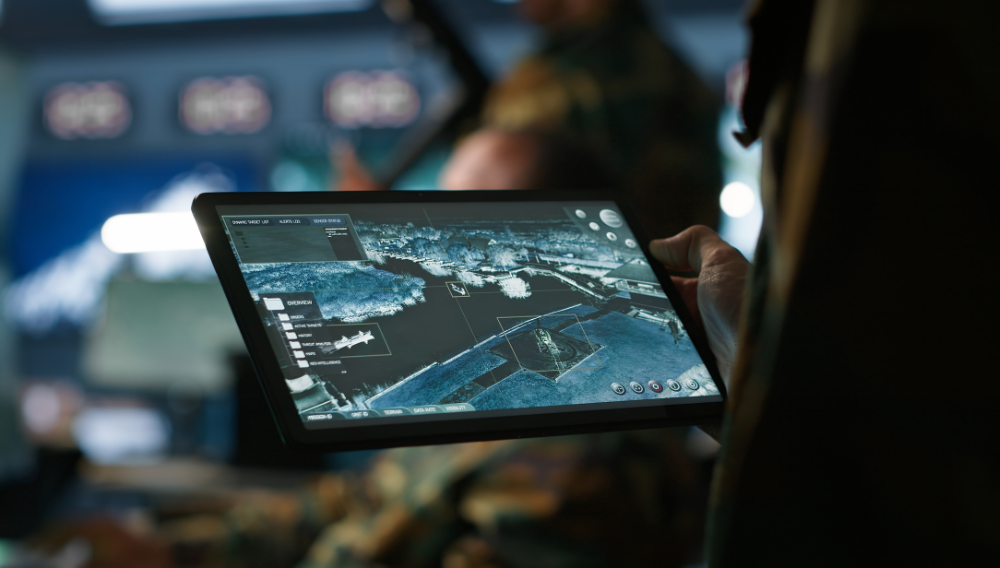4 min read
Decision-making at the Speed of Relevance: The OODA Loop in Modern Defense Systems
 John Breitenbach
:
February 20, 2025
John Breitenbach
:
February 20, 2025

The concept of the OODA Loop – Observe, Orient, Decide, and Act – was developed by military strategist John Boyd. It is focused on the ability to make rapid, informed decisions, widely considered to be the pivotal factor for ensuring mission success. This is even more relevant today, as new threats such as hypersonics and the proliferation of easy-to-deploy drones and rockets have compressed the timeline for the OODA loop.
In modern defense, data is the real weapon. Moreover, data is the connection or central nervous system between each stage of the OODA loop, both at the input and/or output of each step. But can this data be made to move fast enough to support the type of split-second decision-making militaries need moving forward? Yes. We describe it as the “data-centric OODA loop.” A data-centric architecture can enable the pervasive availability of OODA Loop data from different sources in real time, 24/7. And data centricity is the principle that RTI Connext software is built upon. Already in use in 500+ defense programs of record, Connext delivers the framework teams need to keep pace with today’s accelerated evolution of the OODA loop.
To successfully make decisions at the speed of relevance, a data-centric architecture is no longer optional - it’s essential. With Connext in the mix, defensive systems are able to adapt in real time, integrate seamlessly across domains, and leverage automation and AI to maintain a strategic edge. As missile defense, C-UxS, and air defense networks grow more complex, the need for data-centric architectures, modular open systems (MOSA), and AI-enhanced decision-making has never been greater.
The OODA Loop remains a foundational framework for accelerating decision-making in high-stakes operations. Originally conceived for aerial combat, the OODA Loop now underpins modern defensive systems, enabling them to rapidly process sensor data, analyze threats, and deploy countermeasures before an adversary can successfully attack a target. Let’s take a look at the forces that require our current OODA loops to evolve, how each part of the OODA loop must change to adapt to new threats, and a data-centric approach for an agile OODA framework.
The Need for Faster Decision-Making in Defensive Systems
Threats are evolving at an unprecedented pace. Adversaries are leveraging technological advancements to develop hypersonic missiles that are now capable of exceeding Mach 5, rendering traditional response strategies ineffective. Meanwhile, recent conflicts in Russia, the Ukraine, and the Middle East, have demonstrated the growing risk posed by autonomous drones and loitering munitions operating in coordinated swarms. These new technologies are increasingly being paired with greater masses of conventional weapons, such as low-cost rockets and missiles. The goal is no longer to defeat a defensive system, but to overwhelm it with affordable mass.
To stay ahead, defensive systems must act at machine speed – leveraging real-time intelligence, AI-driven analytics, and automation to rapidly detect, assess, and neutralize threats. This shift requires moving beyond traditional, linear decision-making processes with humans in the loop to adaptive, automated responses that dynamically adjust to evolving battlefield conditions in real time.
The Four Components of the OODA Loop
The OODA Loop consists of four critical stages that facilitate swift tactical responses: Observe, Orient, Decide, and Act. Each phase of the OODA Loop plays a key role in enabling rapid, coordinated, and effective defense operations. Each will have to change in the near future to counter the increased volume, velocity, and variety of modern threats.
Observe: In this world of new threats, we’re going to need new sensors; and the ability to connect those sensors together to the latter parts of the OODA loop. The sensors we might employ at any given location may vary to account for hilly vs. flat terrain vs. water environments, or for swarms of small FPVs vs. long-range missiles and hypersonics. Therefore we need a flexible architecture that allows us to add and remove sensors as needed to constantly upgrade capabilities. For effective Counter-UxS initiatives, military personnel need reliable, real-time data from such sources as: multiple surveillance radar systems (air, ground, early warning, etc.), land tactical radios, Electro-Optical/Infra-Red (EO/IR) systems, EW systems, and sometimes even acoustic sensors tuned to recognize specific audio signatures. The ability to synchronize and process this information in real time ensures that decision-makers have an accurate and immediate picture of the battlespace.
Orient: Once threats have been detected, speed is vital – every millisecond matters. Data from many different sensors is fused and analyzed instantaneously to provide a coherent understanding of the full operational picture. AI-driven battle management systems correlate sensor inputs, allowing defensive platforms to prioritize threats based on trajectory, intent, available countermeasures, and magazine depth. Data from external sources such as Friend or Foe (IFF), allied combat systems, and public data sources such as Automatic Dependent Surveillance–Broadcast (ADS-B) enrich and enhance the common operational picture.
This step is crucial in reducing cognitive overload for operators and ensuring that decision-making processes are streamlined and accurate.
Decide: This step involves developing and refining options to form an effective course of action once threats have been identified. As threat speed and volume increase, decision timelines shrink, making AI and machine learning essential in triaging threats and selecting optimal countermeasures. Defensive systems must rapidly determine which threats require immediate action and which can be monitored. At lower threat volumes, humans may still be on the loop, with the space to choose between a few possible options presented by the AI. But as the number of threats sent at any one time increases, these decisions will increasingly be made by AI and ML algorithms. In the case of hypersonic and maneuvering missile threats, reaction time is measured in seconds – this is where AI-driven automation plays a critical role in ensuring that countermeasures are deployed instantly and effectively.
Act: The final step of the OODA Loop is executing precise and synchronized countermeasures. Whether intercepting a missile or deploying directed energy weapons against drone swarms, defensive actions must be both rapid and coordinated. Getting an effect on target, and keeping it there in the case of directed energy, will also require real-time data. Real-time data can help deconflict the target space, even when the time window for taking a shot – either kinetic or non-kinetic – is narrow.
Evolving the OODA Loop with RTI Connext
As threats continue to evolve, success will belong to those who have the right data and who can observe first, orient faster, and act decisively. RTI has a proven track record powering mission critical systems such as the U.S. Navy’s Aegis combat system and remains committed to advancing the capabilities necessary for maintaining a pivotal edge in defense environments. By continuously enhancing its support for AI and integrating seamlessly with existing defense technologies, RTI Connext can support and enhance the OODA Loop, expanding its efficiency as a highly effective framework for military strategy. Learn more about RTI in A&D here.

About the author:

John Breitenbach, Director Aerospace & Defense Markets, RTI
John Breitenbach is Director of Aerospace & Defense Markets for Real-Time Innovations. He has over 30 years of experience designing software for intelligent machines. He’s worked on industrial, medical, consumer and military products - everything from artificial hearts to autonomous vehicles to elevators.
Posts by Tag
- Developers/Engineer (177)
- Connext DDS Suite (77)
- Technology (74)
- News & Events (73)
- 2020 (54)
- Standards & Consortia (51)
- Aerospace & Defense (48)
- Automotive (35)
- 2023 (34)
- 2022 (29)
- IIoT (27)
- Leadership (24)
- 2024 (22)
- Cybersecurity (20)
- Healthcare (20)
- 2021 (19)
- Connectivity Technology (15)
- Military Avionics (15)
- Culture & Careers (14)
- FACE (13)
- Connext DDS Pro (10)
- JADC2 (10)
- ROS 2 (10)
- 2025 (7)
- Connext DDS Tools (7)
- Connext DDS Micro (6)
- Databus (6)
- Transportation (5)
- Case + Code (4)
- Connext DDS (4)
- Connext DDS Cert (4)
- Energy Systems (4)
- FACE Technical Standard (4)
- Oil & Gas (3)
- RTI Labs (3)
- Research (3)
- Robotics (3)
- #A&D (2)
- Connext Conference (2)
- Edge Computing (2)
- MDO (2)
- MS&T (2)
- TSN (2)
- ABMS (1)
- C4ISR (1)
- ISO 26262 (1)
- L3Harris (1)
- LabView (1)
- MathWorks (1)
- National Instruments (1)
- Simulation (1)
- Tech Talks (1)
- UAM (1)
- Videos (1)
- eVTOL (1)
 Success-Plan Services
Success-Plan Services